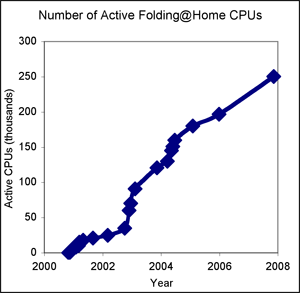Maestro949 - Yes - that was very cool. To think that entire movie is probably a very small fraction of a second and required many thousands of computing hours to generate!
Yes, to think of the orders of magnitude differences in time between the simulated and the simulators. Somewhat indicates where we are in the scheme of things.
Some small proteins fold in 10 microseconds (10 millionths of a second). That protein in the DL.TV video didn't look very large to me, so for thinking purposes lets say it took 10 microseconds. Many of Stanford's simulations take 2-3 years to complete. Looks like right now Stanford F@H is running about 250 protein projects and about 250,000 CPUs. In the past there were fewer projects and fewer contributors. So lets say it takes 1000 CPUs two years to fold a protein.
That's:
(1000 computers x 2 years x 365 days/year x 24 hours/day x 60 minutes/hour x 60 seconds/min) = 6.3 X 10^10 computer-seconds per protein project
to simulate a protein that would
in vivo fold in ten microseconds (0.00001 sec) = 10^ -5 seconds/fold
or, approximately sixteen orders of magnitude between simulation and reality (10^16).
Maybe the protein takes longer to fold, maybe the computers aren't running all the time, and maybe CPUs and PS3s are now much faster... So maybe one or two of the guesstimated numbers are off by a factor of ten.
Some info
directly from Stanford:
A single computer can simulate a nanosecond in a day (one nanosecond = 1 ns = 10 x 10 -9seconds or billionth of a second).
So using a single computer it will take about 30 years to simulate even the fastest folding protein.
Using those numbers:
1 computer x 30 years x 365 days /year x 24 hrs/day x 60 min/hr x 60 sec /min = 9.5 x 10^8 computer-seconds/fold
to simulate protein that would
in vivo fold in ten microseconds (0.00001 sec) = 10^ -5 seconds/fold
or, approximately fourteen orders of magnitude between simulation and reality (10^14).
The gap is telling.
There is much remaining to do...
Maestro949 - Here's my basement lair from where I plot world domination. 8 machines running down there now and 3 upstairs. I just added the shiny silver one to the left after upgrading my primary machine to an Opteron CPU.
Nice photo and nice setup Maestro. Its kind of like what I imagined

What was your deciding factor on the Opteron?
I appreciate AMD products; they certainly help keep Intel in an innovative mode. Hope the upcoming AMD quad "Phenom" is a lightening-fast number cruncher.














































